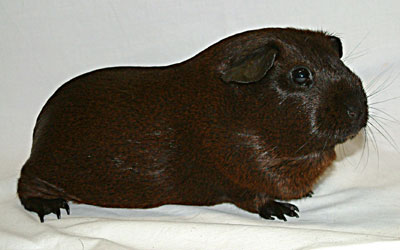
Preparing cavies for a show
Bathing your pet guinea pigs should be carried out a few days before the show. You need to pay particular attention to the grease spot, which is situated where the tail would be if the pig had one. Boars are greasier in this respect than sows. A good way of cleaning this spot is to rub neat Swarfega* into the spot and the coat surrounding it. This will loosen the grease. Leave for a few minutes then rinse thoroughly, before shampooing your guinea pig. For this, you can use any shampoo used for people. Boars’ coats are often greasier than sows’ coats, and may need more than one shampoo to get clean.
*(Swarfega is used by mechanics to get oil off their hands and is sold by Halfords and similar stores. The green coloured Swarfega in the red tub or pump bottle is best.)
You can wash your pig in the kitchen sink. Stand the pig in a washing up bowl in a few inches of warm water and gently pour water all over it with a small jug, going carefully over the head and face, until the pig is wet all over. Then lift the pig out onto the draining board and shampoo it thoroughly, being careful not to get shampoo in its eyes. Next, rinse the coat well, either by pouring clean water over it, or back in the washing up bowl in several changes of water, or by using a hand held shower attachment. Towel dry. Next put the pig on two or three old towels in a plastic basket, with another thick towel over it. Put the box in a warm well-ventilated place to finish drying off, changing the towels for dry ones as often as necessary.
Cavies’ coats can take several hours to dry completely, and so make sure they are quite dry before putting them back in their clean hutch, especially if the weather is cold. Some people use a hairdryer to speed up the drying. You may decide to keep them in overnight if it is very cold outside.
Trim the nails if necessary with clippers or small sharp scissors, and check that the ears are clean. Don’t, however, poke inside with anything like a Q-tip. The ear flap is all you need to check.
If you are showing a longhaired pet cavy, the coat must be neatly trimmed to clear the ground, and have no knots or tangles. These tend to be found at the rear of the pig, or on the inside of the legs, particularly the back ones.
If you are showing a cavy in the pure bred classes, it is best to ask someone how to prepare your partiuclar breed. Generally, the coats of short-haired cavies are shown with the long guard hairs removed. This is achieved by gently rolling the coat between thumb and index finger. If done carefully, it does not distress the cavy and results in a smooth, silky coat. In the first instance, it will probably be best to ask someone to demonstrate the technique to you!
Information on the special methods required to groom and care for the coats of long-haired cavies can be found here.